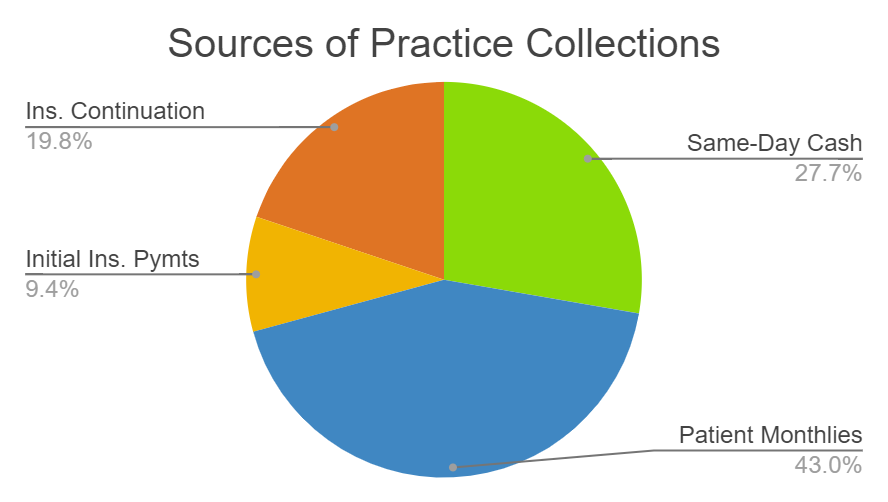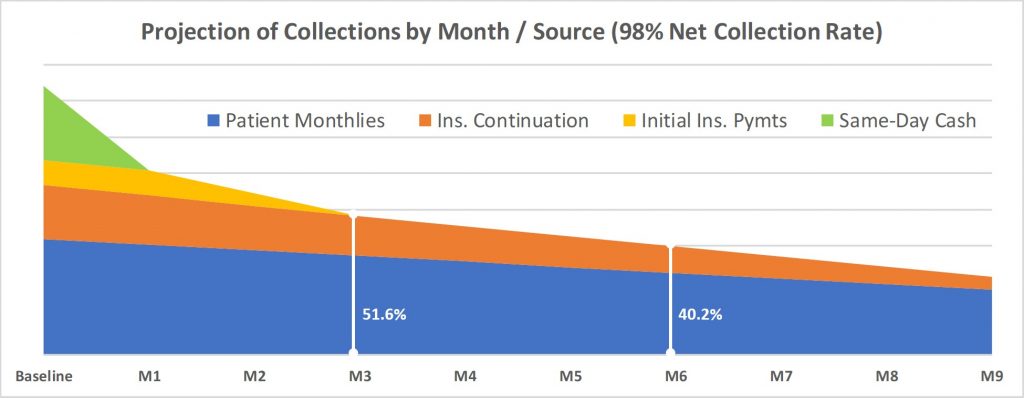Let’s say it again – these are unprecedented times. Even during the Great Recession in 2008, the specialty didn’t experience complete practice shutdowns. Although there is a foreseeable end to this crisis and more proactive government stimulus to support families across the country, it poses unique challenges to business owners. Part of that is forecasting. If you’re trying to rationalize operating costs and staffing changes with the least amount of disruption and hardships for your team, you need to be able to project your income over this period. That’s where OrthoFi’s data can help, whether you’re a customer yet or not. We have data on over $2 Billion of production we’ve processed in over 500 orthodontic practice locations, and outcomes on over $350 Million in active patient and insurance AR. During this shutdown, OrthoFi will pledge to share insights to help the industry.
Let’s start with some baseline numbers, which serve as the foundation for our calculations. Across our 350+ practices, here are the averages:
- Average Starts per Year: 391
- Average Production: $4,644 overall (incl. Limited Tx and Phase I/II), $5,193 for comprehensive Tx
- Average Patient Responsibility: $3,695
- Average Patient Plan Length: 21 Months
- Average Insurance Benefits: $949
- Average Insurance Continuation Payment Timeline: 12 Months
Now let’s break down practice collections. Here are four sources of collections we manage daily:
- Same-Day Cash: The total amount of Pay-In-Fulls (PIFs) plus the initial Down Payments (DPs) received from patients when they start treatment
- Patient Monthly Payments: Ongoing scheduled monthly payments
- Initial Insurance Payments: Typically 25-33% of the total benefit pays within 21 to 45 days after the claim is submitted.
- Insurance Payments: Ongoing continuation payments from insurance companies, varying in cadence by carrier (i.e. monthly, quarterly, semi-annual or annual)
For an average practice using OrthoFi, here is the mix of collection sources over a normal year:

As you can see, 63% of your collections come from recurring patient and insurance payments, which provides some security during times with no new starts. However, as treatment and payment plans complete over time, there is a gradual erosion. Although we all hope the shutdown ends soon, we should all prepare for a 3-month horizon.
So what would happen if the average practice did not start a new patient for 3 months?
Here are the assumptions:
- Same Day Cash: Goes to zero as you are not starting any more patients
- Patient Monthlies: Patients continue to pay you. OrthoFi’s average payment plan length is 21 months. That means every month 1/21 of your patients complete their payment plans reducing your monthly collections each month. In normal circumstances our collection rate is 98%, which means you lose 2% each year to write offs which would lower your expected collections by that amount as well. As we will show in future posts, our data shows no meaningful change in patient payment behavior as we continue collecting for our practices.
- Insurance Initial Payments: Goes to zero after 45 days after your last appliance placement
- Insurance Continuation: Insurance payments continue as planned. OrthoFi data shows the typical insurance benefit pays over an average of 12 months. That means each month 1/12 of plans complete, reducing your monthly collections by that amount.
So projecting out these assumptions over 9 months (current worst-case shutdown scenario), here is a chart of what your collections would look like if you never started another patient:

As this projection shows, your collections are just over 51% of the baseline before the interruption of new starts. After 6 months it is over 40%. So if the current collection rate persists, this can be helpful in planning cost, staffing hour, and headcount reductions.
However, it’s always good business practice to plan for multiple scenarios (i.e. bull / bear). In these turbulent times with a spike in furloughs and financial impact to consumers, you would expect the collections rate on patient AR to go down by some amount. To date, OrthoFi has not seen any meaningful change in autopay success rates (they’ve actually improved over the last few weeks, likely due to personal spending going down). But, the longer the distancing guidelines remain, the more likely we are to see an increase in hardship requests and delinquency. Let’s go extreme with collections rate going from 98% down to 90%. We do not anticipate collections rates to drop. With good fundamentals and a strong collection protocol we expect to continue to see good results, but we want to help you see what would happen.
The interesting note here is that, fortunately, if you want to call it that, due to the decline being a percent of a percent, patient collection rate does not change this picture very much at all. In fact, with an 8-point drop, your collections after 3 months of no new starts is 50.7% (less than a point drop from what it projected at 98%) of what you averaged before your stopped starts. After 6 months the projection is 38.5% of baseline (less than two points off). Given that patient collection rate variances (within a reasonable range) don’t move the needle, this projection can serve as a good guideline to help you plan your financial moves.
You may have noticed that we didn’t model the recovery. At this point, there is too much uncertainty of how long these guidelines will last, which in turn is likely to affect medium to long-term consumer behavior. Financial expert opinions range anywhere from quick V-up patterns to longer post-recessionary climbs. Most agree, though, that the longer things stay this way, the longer the recovery will take. The wild card is consumer perception and behavior. If the public doesn’t feel safe venturing into practices, it will take time to build up their confidence. Or we might see that healthcare offices are seen as safe havens due to the higher hygiene standards and protocols. No one really knows until we get there, but you can count on OrthoFi to share what we know as we know it.
We hope this data can be a valuable resource during this time. We will continue to update these metrics, and add new areas of focus as new meaningful trends emerge.
If you want to automatically receive these updates, please follow us on Facebook. If you have any questions you’d like us to answer, please post your question on our page, or visit us at StartMoreSmiles.com to connect with one of our practice experts.